Uttar Pradesh is the heart of Hindutva country. The mascot of BJP’s political empire that stretches across the nation. Uttar Pradesh is also the party’s template for electoral battles. And the handbook of governance. Uttar Pradesh is the turf of Yogi Adityanath, a fiery political leader thrust into the national limelight four years ago. It will be ground zero for a defining electoral battle in 2022—for the BJP, and for chief minister Yogi.
But to put 2022 in context, the story must go back to May 2021, to the assembly elections in West Bengal. The entire might of the BJP could not dislodge Mamata Banerjee from the throne in the eastern state. An electoral defeat so bruising for the BJP that it already has the Opposition predicting the future for the ruling party at the Centre and elsewhere. But UP is not Bengal. And Yogi is no Mamata.
Even as detractors call him autocratic and a polarising figure, Yogi’s appeal to the BJP’s core voters appears to be growing by the day. With every decisive action, his credentials get stronger, regardless of the barbs thrown at him. To many, he appears to be controversy’s perennially favourite child, who evokes loyalty and hostility depending upon who is on which side. And yet, ahead of the polls, he looks the best bet for the BJP, which hopes to reap dividends equally from his development agenda and his image of a firebrand Hindutva leader.
On the face of it, UP’s electoral turf appears to be less slippery for the BJP, with no crisis of local leadership as such. Unlike Bengal, where it failed to groom any regional leader of substance worthy of taking on the doughty Didi of Trinamool, here it has the redoubtable Yogi leading from the front—poster boy of the BJP’s Hindutva politics, pursuing a development agenda while wearing his core ideology on his sleeves, ever since he was sworn in as chief minister in March 2017. Critics say Yogi runs a high-handed administration that stood totally exposed during the second Covid surge. It is also accused of resorting to extra-constitutional means to steer itself out of tight spots, like the killing of gangster Vikas Dubey or the hush-hush midnight cremation of a Dalit gang-rape victim in Hathras. But the chief minister, occupying what is possibly the most coveted position of power next to the prime minister, has more than his share of admirers.
ALSO READ: In UP Maths, BJP Gives No Quarter
“Yogi has proved himself to be a good administrator beyond all doubts,” political commentator and economist Nawal Kishore Choudhary tells Outlook. “Initially, we had a very poor opinion of him and I thought he wouldn’t be able to administer a vast state like UP. But, judging from his performance, I think he is the best bet for his party under the circumstances.… Like Indira Gandhi in the past or Mamata Banerjee now, it pays to be decisive in Indian politics. I think Yogi has that element in him.”
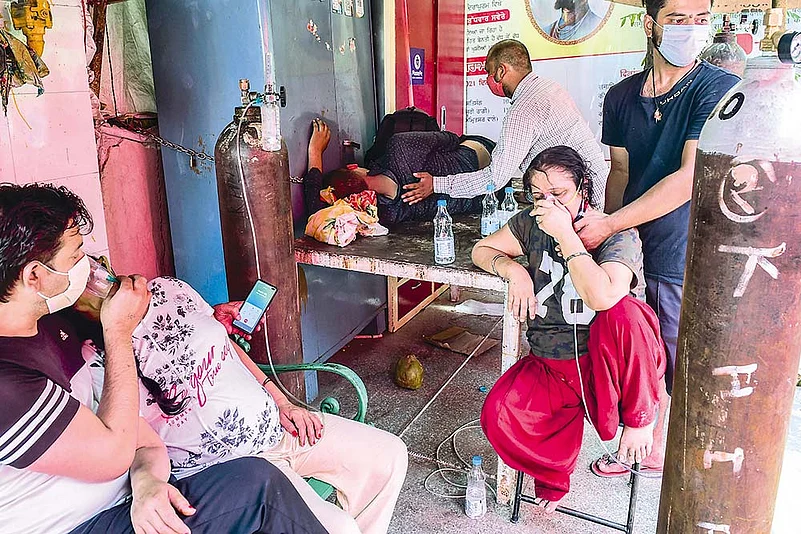
Covid-positive people wait for treatment at a hospital.
It is not something that many had expected of him four years ago. In the run-up to the assembly polls in 2017, the party had refrained from declaring anyone for the chief minister’s post. The top brass chose to try the young monk of the Gorakhnath Math and Gorakhpur MP to sell their dreams of good governance only after the party won 312 of the 403 seats in the assembly. It was a well-calculated gamble that initially evoked enough scepticism in political circles. Yogi had until then won five consecutive Lok Sabha polls from Gorakhpur, but he did not have any administrative experience to govern a state. He was, at best, considered a vocal member of the BJP’s Hindutva brigade, often noticed for his stinging oratory.
ALSO READ: Safely Cornered Out There
Four-and-a-half years on, that image stays, though his supporters claim he has carved a parallel identity for himself as an able administrator by fast-tracking UP’s development with a string of out-of-the-box programmes such as the one-district-one-product (ODOP) scheme aimed at ensuring all-round growth of the state by promoting at least one product from each of the districts at the global level. Whether it is his policy of zero-tolerance against crime and corruption, focus on infrastructure development, or a slew of welfare steps to ameliorate the condition of farmers, youth and women, he is seen as writing a new script of UP’s development.
Nikhilkant Shukla, associate professor at Deendayal Upadhyay Gorakhpur University, recalls Yogi’s work when devastating floods ravaged his constituency soon after he became an MP for the first time in 1998. “Though he was young and inexperienced, he worked round-the-clock to provide relief to people in flood-hit areas,” he says. “There has been no change in his style of functioning. Even as chief minister, he is still working with the same passion and commitment during the Covid crisis.”
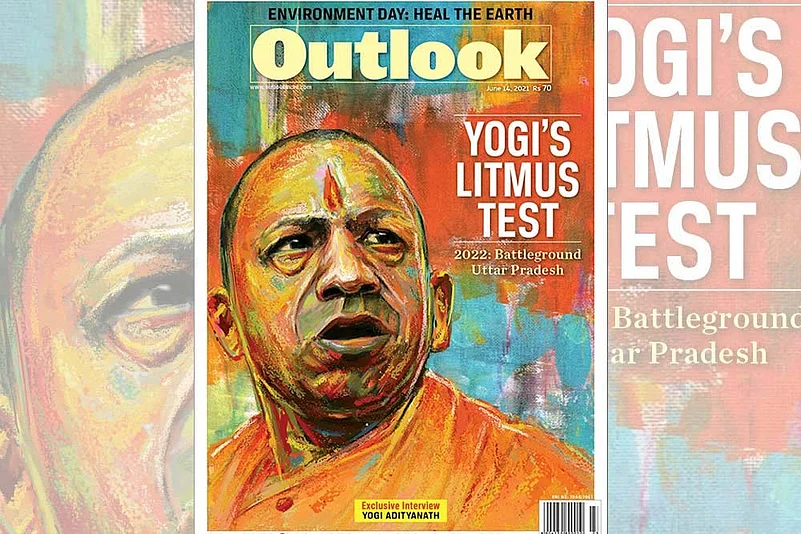
Still, in a politically unpredictable—and crucial—state where caste matters significantly and reflexively, neither the BJP nor Yogi can afford to take it easy in the months ahead. UP has, of course, been a BJP pocket borough for the past seven years, with back-to-back victories in 2014 and 2019 Lok Sabha polls and in the 2017 assembly elections, which brought the party back to power after a 16-year hiatus. From one election to another, the BJP has gained in strength, relegating its main opponents—the Samajwadi Party, Bahujan Samaj Party and Congress—to the sidelines. But every election is different, as they say in politics.
Yogi, therefore, has his task cut out. The loss in Bengal, after all, has not been the only setback for the BJP in recent times. In the UP panchayat elections, its candidates performed poorly even in traditional strongholds such as Ayodhya, Mathura and Gorakhpur. Elsewhere, there has been no let-up in the farmers’ agitation against the Centre’s three new farm laws, especially in western UP where discontent seems to be brewing against the ruling party for over six months. Significantly, it has also led to a realignment of the formidable Jat-Muslim vote bank, which wields considerable influence.
In the 2017 assembly elections, the Jats backed the BJP. They seem to have turned against the party now over the revised farm laws. Muslims are generally expected to rally behind the BJP’s rivals and, hence, Yogi has to prevent a split in votes of all the caste/community blocks that backed his party in previous polls. He has to work out an effective social-engineering formula to retain the support of non-Jatav Dalit and non-Yadav OBC votes, apart from stopping the fragmentation of privileged-caste voters, especially his traditional supporters—Brahmins and Thakurs—who seem to be working at cross purposes over a simmering rivalry.
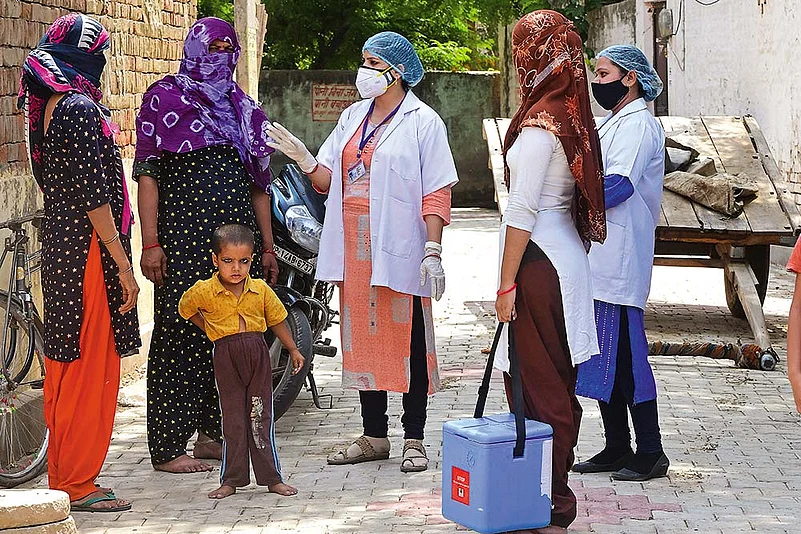
A door-to-door vaccination campaign
YOGI can breathe easy—for the time being at least—over any cohesive challenge from the Opposition, which is a divided house and there is no attempt whatsoever to put up a united fight against the BJP. The so-called consolidation of 19 per cent Muslim votes against the BJP may look ominous. But the presence of multiple parties against the NDA—especially the entry of Asaduddin Owaisi’s AIMIM in the UP battleground—will likely split Muslim votes, thereby serving none of Yogi’s rivals. Rather, the biggest opponent for Yogi at the moment appears to be the fallout of the second wave of the Covid pandemic that has left scores of people dead in the state, including its villages. Disturbing visuals of bodies floating in rivers and mass burials on riverbanks have surfaced from the countryside—barely months after the first wave. With the assembly polls knocking on the door, hard questions are being asked: Will Covid-hit people still vote the BJP? Will the BJP able to keep its winning streak under Yogi’s leadership? In the 2014 parliamentary polls, the BJP won 71 of the state’s 80 seats, but its share came down to 62 in 2019 when the SP and the BSP contested the polls as allies. Elections throw up surprises, though. In the 2017 assembly polls, Akhilesh Yadav joined hands with the Congress, but that could not prevent a massive BJP win.
The Opposition parties are likely to go solo in 2022, but each one will be throwing darts at the same target: Yogi, his image and his alleged Covid mismanagement that killed thousands of people. Is Yogi worried, then? He is unfazed. “The BJP government will come back to power in UP on the strength of its performance,” he tells Outlook in an exclusive interview. “And remember, it will keep coming back. Only the BJP has to stay here.” Yogi has already got into election mode, making trips to the interior—apparently with twin objectives. The tours are helping him monitor first-hand the government’s efforts to contain the coronavirus and letting him reach out to the masses, especially the village folks. Yogi had toured the state’s 75 districts before—within a year of coming to power, and the first chief minister to do so.
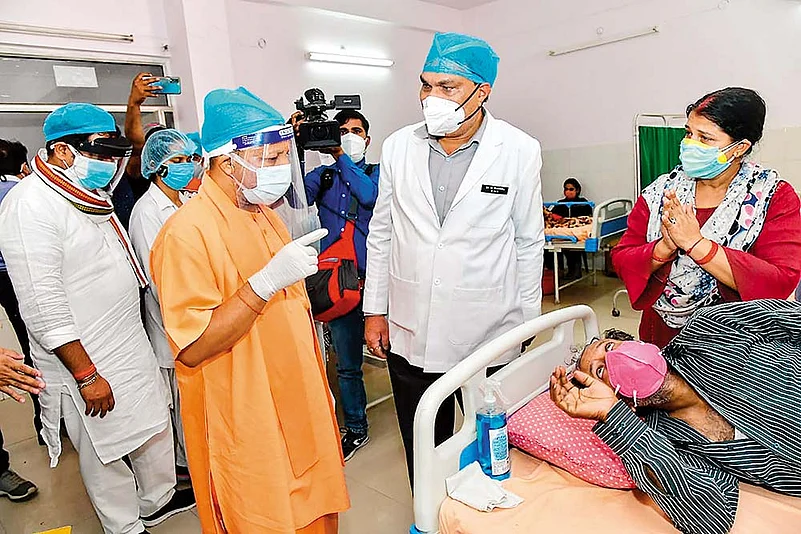
Chief minister Yogi Adityanath meets Covid patients
Yogi insists that the BJP is not focusing merely on his current term. It is working simultaneously on road maps for the next five, 10 and 15 years. His confidence apparently stems from the success of projects launched by his government. In the first four years of his tenure, he claims, UP’s economy grew from Rs 10,90,000 crore to Rs 21,73,000 crore, and attained second position in the country. Also, it is said to have attracted investment proposals worth Rs 2.25 lakh crore, helping the state jump 12 places to become Number Two on the Ease of Doing Business index in India. From creating a wide network of expressways and building airports in remote areas to opening a chain of medical colleges in the interiors, and a mega film city project in Greater Noida, Yogi reels off a long list of achievements from his report card.
The Opposition dismisses his claims. Ajay Kumar Lallu, the state Congress president, says the Yogi government is good at branding itself with hoardings to showcase its non-existent achievements. “All the talk about huge investment is nothing but eyewash. Farmers are suffering and at least 850 of them have died by suicide,” he alleges. “The unemployment rate has doubled, while small traders are facing a lot of hardship. This is the reality.” Rajendra Choudhary, former minister and national secretary of the Samajwadi Party, agrees. “This is the first government that changes the names of old projects launched by previous governments and blatantly passes them off as its own,” he says. “It has weakened the social fabric by overlooking the spirit of the Constitution while making laws against interfaith marriages. Apart from pursuing its agenda of hate, the Yogi government has not done anything at all.”
Yogi has been firm in sticking to all his decisions, controversial or not, which has set the template of his rule. Anti-Romeo squads, cow-protection drives, the crackdown on illegal abattoirs, laws against inter-faith marriages, and the demolition of mafia-owned illegal property, happen to be some of his decisions that raised hackles. The Opposition has accused him of doing little to ensure the safety of women and questioned him for allegedly letting the state police act with “extra-constitutional powers” to stage extra-judicial killings. But Yogi remains defiant. “I am not controversial and I take every step in the interest of the state,” he says. “I am committed to the welfare of our 24 crore people, and it is my responsibility to work for their security and prosperity.”
The BJP government’s thrust on development with special emphasis on checking crime has not exactly reduced criminal activities significantly in UP. The gang rape of a Dalit girl in Hathras, the conviction of BJP legislator Kuldeep Singh Sengar in an abduction and rape case, the killing of eight policemen by gangster Vikas Dubey and his accomplices, followed by Dubey’s killing when cops were bring him to UP from Madhya Pradesh, have cast a shadow on Yogi’s all-is-well claims on law and order.
His biggest challenge came during the second wave of the pandemic. The sudden spike in Covid-positive cases overwhelmed the health system. The crisis exacerbated when medical oxygen and life-saving medicines became unavailable for patients and many died. The shortfall prompted the Opposition to confront the chief minister and seek answers. Former CM Akhilesh Yadav called for a change in leadership in post-Covid UP. “Bodies found floating in the Ganga are not a statistic, they are someone’s father, mother, brother and sister. What has transpired shakes you to your core. There has to be accountability from the very government that has failed its people so badly (sic),” he tweeted. The Samajwadi leader says it was disconcerting to see the pandemic spreading in the villages. For her part, BSP supremo Mayawati accused the Yogi government of fudging the Covid death count. “In rural areas, corona is spreading fast and killing people in large numbers. People are somehow managing to cremate the bodies. The government must come forward to help such families,” she tweeted. The Opposition believes Yogi’s days as CM are numbered. “The recent panchayat polls are an indicator that people are angry at the BJP,” says Rajendra Choudhary, a former SP minister. “The common man has been at the receiving end of the government’s failure to manage the Covid situation. They are not going to be duped again by the BJP in the 2022 polls.”
And for his part, chief minister Yogi asserts that his government brought the Covid situation under control with his 3Ts (test-trace-treat) formula. “It is true that the second wave has been quite severe and, for a while, it overwhelmed the system,” he says. “I don’t think many of us were prepared to tackle that level of severity. Yet, we never let the situation go out of sight. Our policy of 3Ts has allayed apprehensions of the experts who were saying that UP would record one lakh cases a day. Our cases are down by almost 70 per cent than the peak on April 23 when we had 3,10,700 cases. We have done 4.70 crore tests, the maximum by any state so far.” Yogi also scoffs at reports that the shortage of oxygen supply had resulted in many deaths in the state. “I must tell you that there has not been a single death because of the shortage of oxygen in UP,” he contends. He also asserts that the practice of riverside burials is a traditional one, which has taken place for decades in the state. “Some villagers do not cremate their dead due to a Hindu tradition during certain periods of religious significance. Instead, they dispose of the bodies in rivers or bury them in graves on riverbanks. Of course, the practice is detrimental to the ecosystem,” he adds.
Social activist and former scientist Harmesh Singh Chauhan thinks Yogi responded to the situation well. “Families of Covid victims were angry over the hoarding of drugs, oxygen and other essentials by hospitals and chemists during the crisis, but the government took control by taking swift action. The situation has improved now. The public sees everything and it is sympathetic to the Yogi government, because is not filling its own coffers, unlike the previous governments,” he says. “Also, the BJP is in power and it will not sit silently.” Still, it cannot be denied that the two waves of the pandemic proved to be a spanner in Yogi’s development agenda. In March 2020, when the pandemic broke out, he seemed to be well on course to consolidate his position. With no testing facility or Covid-care hospitals in the state, his government had little option but to send patients to Delhi’s Safdarjung hospital and test samples to the National Institute of Virology, Pune. A prolonged nationwide lockdown leading to the return of lakhs of migrant workers from other states posed another big challenge. The chief minister had to spend a substantial part of his tenure—about 15 months—tackling the crisis. Will all of it play out in the all-important elections?
Political analyst J.P. Shukla believes people might be angry at the Yogi government at the moment because of their personal losses, but it cannot be said that they will remain angry till the elections next year. “The CM has been touring every district and connecting directly with people in rural areas these days. It cannot be overlooked,” he says. His people-connect, when they are angry, is likely make a significant difference in 2022. Social scientist Prof B.N. Mishra thinks the next UP elections will be completely Yogi-centric. “He might face some challenges in 2022 because the Opposition at times benefits not from its own work, but from the mistakes of the party in power,” he says. “Still, the Yogi factor will matter.”
Whatever happens, the upcoming elections may evolve into a referendum on Yogi’s performance more than anything else and its outcome is likely to have a bearing on the political landscape beyond the periphery of the most populous state, regardless of which way the people’s verdict goes.
***
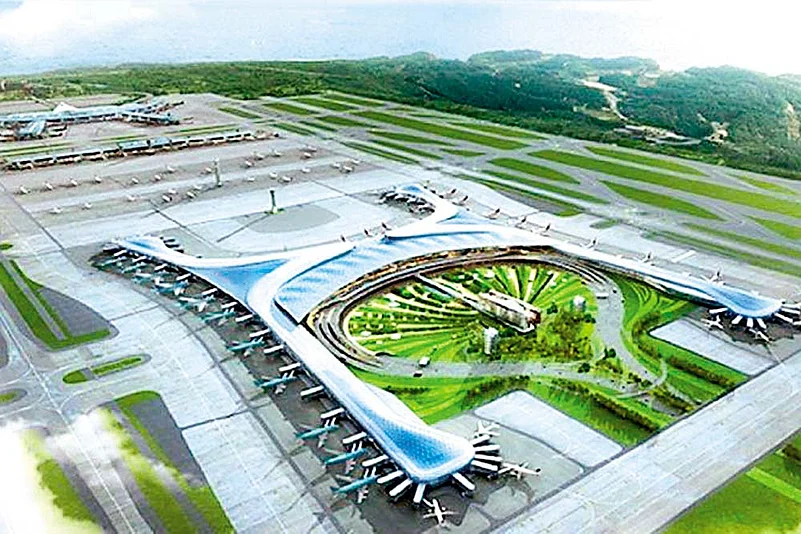
Out Of The UP Box
Anti-Romeo Squad
After taking over as UP CM in 2017, Yogi Adityanath launched anti-Romeo squads apparently to check harassment of girls and women, but it soon kicked up a row, as state cops were accused of acting as moral guardians to harass couples in public places.
Anti-love jehad law
The Yogi government promulgated the controversial Uttar Pradesh Prohibition of Unlawful Religious Conversion Ordinance, 2020, unofficially known as the ‘anti-Love Jehad law’, which among other things required religious conversions for marriage in Uttar Pradesh to be approved by the district magistrate.
Demolition drive
The Yogi government amended the Uttar Pradesh Gangsters and Anti-Social Activities (Prevention) Act, 1986, to launch a crackdown for confiscating or demolishing properties belonging to the high-profile mafia, including politicians with criminal antecedents.
Crackdown on Slaughterhouses
The chief minister ordered a ban on cow smuggling and a crackdown on illegal slaughterhouses in the state, but it triggered controversies with his detractors alleging that it was aimed at harassing people from a particular community.
Mega Film City
Yogi Adityanath has an ambitious plan to launch a mega world-class Film City in Greater Noida with state-of-the-art facilities, but it pitted him in direct confrontation with his Maharashtra counterpart Uddhav Thackeray amid speculations that he wants to shift Bollywood from Mumbai to UP.
One-district-one-product (ODOP)
One of Yogi Adityanath’s pet projects, it aims at promoting at least one unique product from each of the districts in the state, not only to give them an economic boost, but also to protect local crafts and skills that were dying for want of government patronage.
Air connectivity
There were only two functional airports when Yogi took over. Now, there are eight. Work is on at 16-17 more airports—in Azamgarh, Shravasti, Sonbhadra, Chitrakoot, Lalitpur et al.
Medical Colleges
There were only 12 government medical colleges in Uttar Pradesh till 2016-17. Now, the Yogi government is building 30 new government medical colleges. More will come in PPP mode in the rest of the districts.
(With inputs from Prashant Srivastava in Delhi and Bharat Singh in Lucknow)
















